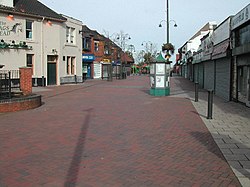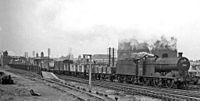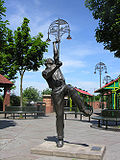Kirkby-in-Ashfield
| Kirkby-in-Ashfield | |
| Nottinghamshire | |
|---|---|

| |
| Location | |
| Grid reference: | SK5056 |
| Location: | 53°6’0"N, 1°15’0"W |
| Data | |
| Population: | 25,265 |
| Post town: | Nottingham |
| Postcode: | NG17 |
| Dialling code: | 01623 |
| Local Government | |
| Council: | Ashfield |
| Parliamentary constituency: |
Ashfield |
Kirkby-in-Ashfield is a market town in Nottinghamshire. It is heavily influenced by nearby Mansfield.
Kirkby lies on the eastern edge of the Erewash Valley which separates Nottinghamshire from Derbyshire. The town's name betrays a Danish origin: Kirk by is Old Danish or Old Norse for "Church Town".
The town is a conglomeration of small villages including Old Kirkby, The Folly (East Kirkby), Nuncargate and Kirkby Woodhouse. It is mentioned in the Domesday Book. Kirkby has two main churches, St Wilfrid's, a Norman church, which was gutted by fire 6 January 1907 but quickly re-built to its former glory and St Thomas's built in the early 1910s in neo-gothic style.
History and heritage
Kirkby-in-Ashfield was once an important centre of coal mining and railways in west Nottinghamshire, with three active coal mines and a several railway junctions.[1] The former Mansfield and Pinxton Railway from the Erewash Valley Line was joined here by the later Midland Railway line from Nottingham. The Great Central Railway main line passed to the south west side of the town and had a double junction with the Great Northern Railway Leen Valley Extension line to Langwith Junction and the Mansfield Railway to Clipstone.
The town rapidly expanded during the Victorian era. However the closure of the coal mines in the 1980s and early 1990s lead to a major slump in the local economy and the area suffered a high level of socio-economic depression.

The railways were closed during the Beeching era leaving the town without a fast link to central Nottingham and nearby Mansfield. The Railway re-opened in the 1990s as part of the 'Robin Hood' line.
The town is currently undergoing a revival and is progressively changing from a traditional mining town to a commuter base of the "Greater Nottingham" area, however the transition from industrial centre to commuter suburb is in its infancy and will take some years to develop.

The town's most famous resident is Harold Larwood; the England cricketer who was born in Nuncargate in 1904. Best known for his 'fast leg theory', unleashed in a devastating manner in the infamous "bodyline tour"; the Ashes Test series in Australia in 1932-33. Bodyline bowling was forbidden by the laws of cricket soon afterwards.
About the town
The area around St Wilfrid's Church is designated a conservation area, and consists of former farm buildings built from local stone, some of which are listed. In the conservation area, at the junction of Church St, Chapel St, and Sutton Road, is Kirkby Cross. This is the remains of a thirteenth century village cross in dressed stone, and is a listed structure and designated ancient monument. It is thought the cross has been in place since 1218, some years before the village was granted a market and fair. It was nearly demolished by an articulated lorry in early December 1987, but has been restored.
On the edge of Kirkby is Portland Park (known to local people as "the quarries") a mixture of woodland and grassland areas which, together with a number of small ponds and streams, are home to a wide variety of wildlife. The visitor centre there was opened in October 1994, and is an environmentally friendly building and a centre of excellence for energy conservation.
The 1981 gentle Sunday evening programme 'Shillingbury Tales' was based on old Kirkby, as the writer Francis Essex's aunt lived nearby. The characters were based on locals who used to know his aunt. Filming was switched to Albury in Kent at the last minute because of costs and lack of space for filming.
Places of interest
- Newstead Abbey
- Sherwood Observatory
Outside links
| ("Wikimedia Commons" has material about Kirkby-in-Ashfield) |
References
- ↑ Railway Junction Diagrams 1914 page 143, Ian Allan Ltd reprint, ISBN 0-7110-1256-3
